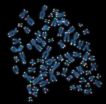(Press-News.org) LA JOLLA, CA-Like cats, human cells have a finite number of lives-once they divide a certain number of times (thankfully, more than nine) they change shape, slow their pace, and eventually stop dividing, a phenomenon called "cellular senescence".
Biologists know that a cellular clock composed of structures at the chromosome end known as telomeres records how many "lives" a cell has expended. Up to now, investigators have not yet defined how the clock's ticking signals the approach of cellular oblivion.
In a study published in the Oct. 3, 2010, issue of Nature Structural and Molecular Biology, a team led by Jan Karlseder, Ph.D., at the Salk Institute for Biological Studies reports that as cells count down to senescence and telomeres wear down, their DNA undergoes massive changes in the way it is packaged. These changes likely trigger what we call "aging".
"Prior to this study we knew that telomeres get shorter and shorter as a cell divides and that when they reach a critical length, cells stop dividing or die," said Karlseder, an associate professor in the Molecular and Cell Biology Laboratory. "Something must translate the local signal at chromosome ends into a huge signal felt throughout the nucleus. But there was a big gap in between."
Karlseder and postdoctoral fellow Roddy O'Sullivan, Ph.D., began to close the gap by comparing levels of proteins called histones in young cells-cells that had divided 30 times-with "late middle-aged" cells, which had divided 75 times and were on the downward slide to senescence, which occurs at 85 divisions. Histone proteins bind linear DNA strands and compress them into nuclear complexes, collectively referred to as chromatin.
Karlseder and O'Sullivan found that aging cells simply made less histone protein than do young cells. "We were surprised to find that histone levels decreased as cells aged," said O'Sullivan, the study's first author. "These proteins are required throughout the genome, and therefore any event that disrupts this production line affects the stability of the entire genome."
The team then undertook exhaustive "time-lapse" comparisons of histones in young versus aging cells and confirmed that marked differences in the abundance and variety of histones were evident at every step as cells moved through cell division.
O'Sullivan calls the "default" histone pattern displayed by young cells "happy, healthy chromatin." By contrast, he says, aging cells appear to undergo stress as they duplicate their chromosomes in preparation for cell division and have difficulty restoring a "healthy" chromatin pattern once division is complete.
Comparisons of histone patterns in cells taken from human subjects-a 9- versus a 92-year-old-dramatically mirrored histone trends seen in cell lines. "These key experiments suggest that what we observe in cultured cells in a laboratory setting actually occurs and is relevant to aging in a population," says Karlseder.
The initiation of diseases associated with aging, such as cancer, is largely attributed to DNA, or genetic, damage. But this study suggests that aging itself is infinitely complex: that progressive telomere shortening hastens chromosomal aging by changing the way genes entwine with histones, so-called "epigenetic" changes. How DNA interacts with histones has enormous impact on whether genes are expressed-hence the current intense interest in the relationship of the epigenomic landscape to disease states.
Rescue experiments in which the team cosmetically enhanced aging cells confirmed that signals emitted by eroding telomeres drove epigenetic changes. When aging cells were engineered to express telomerase, the enzyme that restores and extends stubby telomeres, those rejuvenated cells showed histone levels reminiscent of "happy, healthy chromatin," and a partial return to a youthful chromatin profile.
Lest you sink your savings into schemes to elongate your telomeres, beware. "The flip side of elongating telomeres is that you enable cells to grow for much longer periods and can generate what are called "immortal" cells," says Karlseder. "That takes you one step closer to cancer cell development."
Up to now, the Karlseder lab has mostly focused on interactions between telomeres and DNA repair mechanisms. This paper now pushes them into the field of epigenetics. "We will continue to examine epigenetic changes in cells at different ages," says Karlseder. "We now want to determine if histone changes follow a linear process or whether they kick in as we age."
INFORMATION:
Also contributing to this work were Stuart Schreiber, Ph.D., of the Broad Institute of Harvard and MIT and Howard Hughes Medical Institute and his postdoctoral fellow Stefan Kubicek, Ph.D.
The study was funded by the National Institutes of Health, the George E. Hewitt Foundation for Medical Research, and the Ernst Schering Research Foundation and the European Union.
About the Salk Institute for Biological Studies:
The Salk Institute for Biological Studies is one of the world's preeminent basic research institutions, where internationally renowned faculty probe fundamental life science questions in a unique, collaborative, and creative environment. Focused both on discovery and on mentoring future generations of researchers, Salk scientists make groundbreaking contributions to our understanding of cancer, aging, Alzheimer's, diabetes and infectious diseases by studying neuroscience, genetics, cell and plant biology, and related disciplines.
Faculty achievements have been recognized with numerous honors, including Nobel Prizes and memberships in the National Academy of Sciences. Founded in 1960 by polio vaccine pioneer Jonas Salk, M.D., the Institute is an independent nonprofit organization and architectural landmark.
The Salk Institute proudly celebrates five decades of scientific excellence in basic research.
Ticking of cellular clock promotes seismic changes in the chromatin landscape associated with aging
2010-10-04
ELSE PRESS RELEASES FROM THIS DATE:
Earlier, more accurate prediction of embryo survival enabled by Stanford research
2010-10-04
STANFORD, Calif. — Two-thirds of all human embryos fail to develop successfully. Now, in a new study, researchers at the Stanford University School of Medicine have shown that they can predict with 93 percent certainty which fertilized eggs will make it to a critical developmental milestone and which will stall and die. The findings are important to the understanding of the fundamentals of human development at the earliest stages, which have largely remained a mystery despite the attention given to human embryonic stem cell research.
Because the parameters measured by ...
Auxogyn licenses noninvasive embryo assessment technology from Stanford University
2010-10-04
MENLO PARK, Calif. – October 4, 2010 – Auxogyn, Inc., a privately held medical technology company focused on women's reproductive health, today announced that it acquired an exclusive license from Stanford University to develop a set of products that may allow medical practitioners in the field of assisted reproduction to significantly improve the effectiveness of in vitro fertilization (IVF) procedures.
The technology licensed from Stanford is described in a publication titled 'Non-invasive imaging of human embryos before embryonic genome activation predicts development ...
Can telemedicine improve geriatric depression?
2010-10-04
PROVIDENCE, RI -- Studies have shown a high rate of depression among elderly homebound individuals, and few patients receive adequate treatment, if any. To address this issue, researchers at Rhode Island Hospital and other organizations have developed a telemedicine-based depression care protocol in home health care. The early findings from their pilot study will be presented at the 29th Annual Meeting and Exposition of the National Association for Home Care and Hospice on October 3.
Thomas Sheeran, PhD, ME, clinical psychologist in the department of psychiatry at Rhode ...
OHSU research reveals possible method for boosting the immune system to protect infants against HIV
2010-10-04
PORTLAND, Ore. - - Researchers at Oregon Health &Science University may have uncovered a new weapon for combating HIV as it is passed from mother to newborn child. The research, which was led by researchers at OHSU's Oregon National Primate Research Center, will be published in the October 3rd online edition of the journal Nature Medicine.
"Mother-to-infant transmission of HIV is a tremendous worldwide problem, especially in several African nations," said Nancy Haigwood, Ph.D., researcher and director of the Oregon National Primate Research Center at OHSU.
According ...
Elasticity found to stretch stem cell growth to higher levels
2010-10-04
One of the major challenges in stem cell transplants is how to obtain sufficient numbers of these remarkably rare cells to put into patients. To help overcome this issue, research from the Centenary Institute, Royal Prince Alfred Hospital and the University of Sydney has found a way to increase the number of blood-forming stem cells when growing them outside of the body.
By using a unique stretchy surface that allows the cells to pull on it, the researchers found they could generate up to three times more stem cells than using current methods alone. Published today in ...
The secret life of Ireland's smooth-hound sharks
2010-10-04
They grow to over a meter in length, can weigh up to twelve kilos and each summer they swarm into the shallow waters of the Irish east coast. Despite this, the starry smooth-hound has remained Ireland's least well known shark species. However, thanks to researchers at University College Dublin, whose work is now published in the Journal of Fish Biology, this may be about to change.
Dr. Edward Farrell, who recently graduated from UCD School of Biology & Environmental Science, spent the last four years studying these unusual sharks. Under the supervision of Dr. Stefano ...
New study highlights sexual behavior, condom use by US individuals ages 14 to 94
2010-10-04
BLOOMINGTON, Ind. -- Findings from the largest nationally representative study of sexual and sexual-health behaviors ever fielded, conducted by Indiana University sexual health researchers, provides an updated and much needed snapshot of contemporary Americans' sexual behaviors, including a description of more than 40 combinations of sexual acts that people perform during sexual events, patterns of condom use by adolescents and adults, and the percentage of Americans participating in same-sex encounters.
The National Survey of Sexual Health and Behavior (NSSHB) was conducted ...
Study finds foreclosure crisis had significant racial dimensions
2010-10-04
Princeton, NJ – September 30, 2010 – Although the rise in subprime lending and the ensuing wave of foreclosures was partly a result of market forces that have been well-documented, the foreclosure crisis was also a highly racialized process, according to a study by two Woodrow Wilson School scholars published in the October 2010 issue of the American Sociological Review.
Woodrow Wilson School Ph.D. candidate Jacob Rugh and Woodrow Wilson School's Henry G. Bryant Professor of Sociology and Public Affairs, Douglas Massey, assessed segregation and the American foreclosure ...
Food allergies raise risk of asthma attacks
2010-10-04
Food allergies are more common among people with asthma and may contribute to asthma attacks, according to one of the most comprehensive surveys of food allergies ever undertaken. National Jewish Health Associate Professor of Pediatrics Andrew H. Liu and his colleagues also report in the November 2010 Journal of Allergy and Clinical Immunology that food allergies are more prevalent among children, males and non-Hispanic blacks.
"Our study suggests that food allergies may be an important factor, and even an under-recognized trigger for severe asthma exacerbations," said ...
Study focuses on mephedrone use in Northern Ireland post-ban
2010-10-04
Researchers at Queen's University Belfast have completed one of the first studies of mephedrone use in Northern Ireland since the drug was outlawed earlier this year. They found that the ban did not deter those mephedrone users surveyed from taking the substance.
Interviews with 23 mephedrone users were completed during a two-month period (May and June 2010) following the legislation that made the drug illegal in the UK. Study participants were aged 19 to 51 years, around half of whom (12) were female. 19 of the 23 people who took part in the study were employed, and ...


